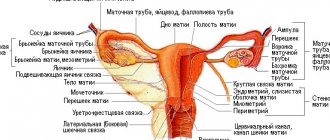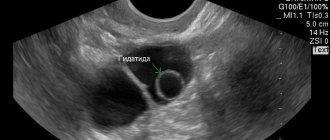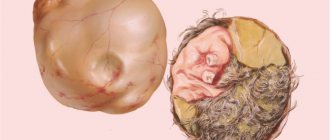Dangerous consequences
Pathology is provoked by a huge number of environmental factors. Modern women do not take care of themselves at all, they constantly subject their bodies to physical activity, and all this over time negatively affects their body. The disease can develop over years and be diagnosed at a late stage. It is for this reason that you need to undergo preventive examinations with a gynecologist at least once a year.
In general, the prognosis for treating the disease is favorable; the main thing is to seek help from qualified specialists in a timely manner, and not listen to the advice of neighbors who once encountered a similar illness and were cured with tinctures or ointments. Treatment of varicose veins of the uterus must be carried out without fail, because the disease can provoke dangerous consequences:
- thrombophlebitis - a disease of the walls of the uterus, followed by the formation of blood clots on them;
- ovarian vein thrombosis - blockage of blood vessels.
Both pathologies can be fatal without timely medical care.
Veins affected by varicose veins of the uterus must be removed surgically
Causes of the disease
Varicose veins of the uterus are associated with hormonal imbalances and thyroid function. The disease develops as a result of increased blood clotting in the pelvic organs.
Varicose veins of the uterus can have the following causes:
- prolonged inflammation of the organ;
- abortion;
- difficult childbirth;
- frequent constipation;
- intrauterine contraception;
- congenital pathologies;
- venous valve defects;
- advanced varicose veins on the legs;
- hereditary predisposition to the disease;
- physical exercise;
- taking hormonal contraceptives;
- uncontrolled use of medications.
Only a qualified doctor can accurately determine the causes of the development of degenerative changes in blood vessels after a thorough examination and interview of the patient.
Cervical varicose veins sometimes develop during pregnancy. Since the fetus is unevenly located in the abdominal cavity, it can compress the uterine veins in the later stages. Varicose veins of the uterus during pregnancy are not considered a pathology and do not require treatment; immediately after the birth of the child, blood circulation is normalized. In some cases, doctors recommend a cesarean section to avoid rupture and hemorrhage during pushing.
Complications of the disease
How dangerous is the disease? If cervical varicose veins are not diagnosed in a timely manner, complications may arise that will lead to reproductive dysfunction:
- Damage to veins.
- Massive hemorrhages.
- Inflammation of the uterus and appendages.
- Inability to become pregnant and bear a child.
The disease can progress and lead to the development of the following conditions:
- Functional failure of the genital organs.
- Thrombosis, most often in pregnant women.
- Abdominal pain.
- Anxiety and increased irritability.
The disease significantly complicates intimate life, up to the development of vaginismus and fear of sexual intercourse.
Symptoms of varicose veins of the uterus
The complexity of the situation lies in the fact that the symptoms of this disease are very similar to other disorders of the genitourinary system, and therefore can be easily confused, and treatment will be carried out incorrectly. Uterine varicose veins have pronounced symptoms only at stage 2. In the initial stages, the disease does not make itself felt at all. It can be determined at stage 1 by chance during a routine ultrasound examination.
Symptoms of dilated uterine vessels:
- nagging pain and discomfort in the lower abdomen;
- feeling of heaviness in the lower back;
- disruptions in the menstrual cycle;
- pain during sexual intercourse;
- heavy menstruation;
- atypical discharge;
- general weakness;
- decreased performance.
All of the above symptoms are a good reason to consult a doctor. Conducting self-diagnosis and prescribing treatment on your own is strictly prohibited; this can only be done by a qualified doctor on an individual basis.
Prevention of varicose veins of the uterus
To prevent pathology of the uterine veins, it is necessary to increase physical activity, eat right and do special gymnastics. For varicose veins, it is useful to rest with your legs raised up to improve outflow.
There is no need to make a diagnosis yourself based on the signs, since even a doctor is not always able to tell whether there is a pathology or whether these are symptoms of other gynecological diseases. Pain syndrome does not mean the presence of varicose veins of the uterus.
Diagnosis and drug treatment
Computed tomography and radiography are uninformative procedures in diagnosing a disease such as varicose veins of the uterus. Much more information about the patient’s condition can be obtained using an ultrasound examination.
A special probe is inserted transvaginally, which allows one to assess the condition of the vessels in the uterus. Additionally, laboratory tests are prescribed to evaluate the composition of the blood. An increased platelet count can interfere with normal blood circulation and cause a number of negative consequences for the body. Very often, uterine varicose veins are combined with dilated veins in the ovary, so the doctor must also examine the appendages.
When diagnosing varicose veins in the uterus, treatment is carried out using two methods - conservative and surgical. Conservative treatment consists of taking the following medications:
- Detralex;
- Phlebodia;
- Normoven;
- Troxerutin;
- Venarus.
Additionally, medications are prescribed that can thin the blood, for example, Thrombo ACC, Heparin, Cardiomagnyl.
Schematic representation of varicose veins of the uterus
If the disease was diagnosed at a late stage or drug therapy did not bring the expected results, surgical intervention is performed. There are several surgical treatment options:
- phlebectomy;
- sclerotherapy;
- laser coagulation;
- radio wave coagulation;
- traditional surgical excision.
Each treatment method has its own characteristics and nature of implementation. For example, phlebectomy involves removing varicose vessels through incisions; with laser coagulation, the outflow of blood is normalized by the action of a laser beam on clogged vessels. Sclerotherapy is a procedure in which a sclerosing substance is injected into the affected vessels to glue the vessel together. With radio wave coagulation, the veins are exposed to radio waves of a certain frequency, they destroy blockages and cleanse the blood vessels.
Cardinal methods include removal of a certain section of the uterine vein, or removal of the uterus and its appendages entirely. The advisability of using a particular treatment method is decided individually, taking into account the patient’s age, the presence of offspring and concomitant diseases.
Symptoms and signs
In the overwhelming majority of cases, varicose veins of the uterine vessels occur with hidden or not clearly expressed symptoms. Some of the most frequently voiced complaints are discomfort during or after sex, as well as during physical activity and during menstruation. Sometimes there is increased vaginal sensitivity, increased symptoms of PMS and an increase in the interval between menstruation to 1.5-2 months.
These symptoms are characteristic of many pathologies of the pelvic organs. Therefore, diagnosing varicose veins in the uterus is quite difficult. According to statistics, only 10% of patients with this pathology can be diagnosed at the onset of the disease. If misdiagnosed, the disease continues to progress and can lead to serious consequences over time.
Diet and physical therapy
During treatment and after surgery, it is very important to maintain a healthy lifestyle and eat right. Increase the amount of vitamin-containing foods in your diet; cucumbers, cranberries, celery, tomatoes and cherries have a very good effect on the condition of veins. Limit the consumption of fried, fatty and smoked foods, as they contribute to vascular blockage and reduce the rate of absorption of vitamins. You should give up bad habits, spend more time in the fresh air and not stay in the same position for a long time. Any physical activity to which a woman exposes herself must be feasible.
Varicose veins of the uterus are corrected by physical exercises, which will increase the tone of the muscles and blood vessels in this organ. The following physical exercises have a very good effect on the condition of patients:
- Lie on your back, place your hands on the floor with your palms, and make movements with your legs that imitate riding a bicycle.
- In the same position, we do the “scissors” leg exercise 30 times. After this, we turn over onto our stomach. We raise the body, resting our elbows on the floor, and perform the same movements with our legs. In this position, it is more difficult to manipulate the limbs, but the effect is greater.
- In a sitting or standing position, retract the anus. They combine such movements with proper breathing - draw in air as you inhale, and release air as you exhale. 15 retractions once a day are enough.
- Sit on the floor, bend one knee and straighten the other leg. The straightened leg is slowly raised and lowered 20 times. After this, the leg is changed.
These simple exercises, which will not take you a little time, can improve blood circulation in the pelvic organs and directly in the uterus. As an additional load, you can climb up the stairs, this also has a great effect on blood circulation and strengthens the muscles in your legs.
Childbirth due to varicose veins
Natural childbirth is allowed only if there is no suspicion of blood clots, since during labor, pushing increases the intra-abdominal pressure greatly and there is a risk of a blood clot breaking off. If there are no contraindications for natural childbirth, a woman should give birth in compression stockings. Caesarean section is indicated for all pregnant women who suffer from heart disease and chronic diseases with circulatory failure.
Prevention of varicose veins is the best way to combat the disease, especially if all women in the family suffer from it. It is carried out in two directions - reducing the load on the legs and improving blood circulation. Fatty, smoked, fried and spicy foods should be excluded from the diet. Perform feasible physical exercises every day, for this it is enough to devote only 5 minutes. And of course, visit your doctor regularly.
Folk remedies and recipes
The following folk methods are excellent for thinning the blood and improving circulatory processes:
- Dilute a spoonful of vinegar into a glass of water. Use 2 times a day before meals.
- Horse chestnut tincture not only strengthens blood vessels, but also improves immunity. You can buy it ready-made at the pharmacy or prepare it yourself by mixing chopped chestnuts and alcohol. The product is infused for 2 weeks in a glass container with a tightly closed lid. Take 20 drops orally before meals.
- Propolis perfectly cleans blood vessels in its natural form and in the form of a decoction. It is recommended to dissolve a slice of the product over an hour or prepare a decoction based on it, simply pour boiling water over the propolis and leave for 20 minutes. It should be noted that the drug can harm people with hypertension, as it accelerates blood circulation in the body and provokes a hypertensive crisis.
- A tincture of lilac and alcohol very well eliminates congestion in the pelvic organs. You need to mix 200 g of plant flowers with 0.5 liters of alcohol and leave for 2 weeks. Next, 1 tsp. Do not take the product before each meal; do not drink or eat it.
- A decoction of hop cones helps a lot. They are brewed in boiling water for 15 minutes, left for half an hour and drunk half a glass, 2 times a day.
Uterine varicose veins are a very serious pathology, so in this case you should not get carried away with traditional therapy. It can act as an addition to the main treatment, and in no case should it be used separately. Now, you know what varicose veins of the uterus are and you roughly know how to treat this disease, so at the first symptoms you can quickly consult a doctor and stop the disease at an early stage, preventing it from developing into a chronic form, which is considered incurable.











